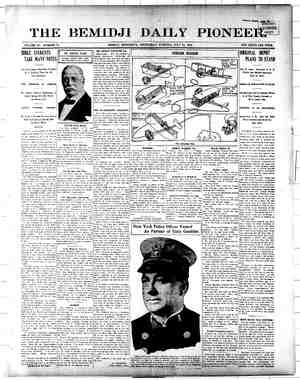Grand Rapids Herald-Review Newspaper, July 24, 1912, Page 13
You have reached the hourly page view limit. Unlock higher limit to our entire archive!
Subscribers enjoy higher page view limit, downloads, and exclusive features.
Two SUPPLEMENT TO GRAND RAPIDS HERALD-REVIEW, WEDNESDAY, JULY 24, 1912. The Forest Products Are The First Crop Most of the land is wooded. The lumberman took the white pine and Norway and did not care for the rest. He left more than he teok. The cedar and tamarack and elm and birch and ash and poplar and other wood are ready to harvest when the settler comes to his land. They will often pay for the land and help pay for the clear- ing. Ties are always wanted. White pine and oak command the best prices. Cedar and tamarack are the largest supply, averaging about thirty cents apiece on track. ‘Ten cents apiece is the standard seale for hewing ties. A good man can make forty to fifty a day. Charles Vetter of Wirt has a rec- ord of seventy ties a day, but a man who ean earn five dollars a day getting out ties is doing pretty well. Cedar and tamarack and some other wood is available for posts and poles. Poles are twenty to forty foot lengths, posts are the ordinary seven foot fence posts. An expert will shave the bark from a cedar post in exactly two minutes and the pay is two cents apiece for peeling posts. Ordinary This is a wooded country; among the pines near Trout Lake. Sastastectestectactestestectectectestectectestestecton’ rock Sestestestesteateo’ Soaks Fa a as a a a a a Ss ON 2 skill will earn $2 to $2.50 a day peeling posts and poles. Spruce is wanted for pulpwood. It is taken by the paper mills at Grand Rapids, at Interna- tional Falls, at Cloquet and is even shipped to Wisconsin. The prevailing price is $5.50 a cord at the mill. : Birch, oak, maple and other wood has a mar- ket value of $4 a cord for fuel. It is used to some extent in the range towns and is sometimes shipped to Dakota. Cordwood at that price will pay fair wages for getting it out and something over. Furniture and package factories take all other kinds of wood. Every sort can be used for box and erate lumber. Birch, maple and poplar are useful for interior finish. Elm, bass and so on are used by furniture factories for lining. Elm, bass and poplar are made into firkins and tubs in the package factories at Cohasset and at Hill City. Ash, besides other uses, is particularly adapte4 for handles. For the inferior lumber the prices range from $6 and $7 a thousand in the log up to $10 and $12 a thousand, according to location, quality and kind. With the paper mill at Grand Rapids and others in adjoining counties, with the package fac- tory at Cohasset and others near by, with the fac- tory at Warba working up lumber for interior finish, with the small country mills, taking every- thing that comes along, with the unlimited de- mand for posts and poles and ties, there is always a market for what the settler takes off his land. Second growth and hardwood runs into con- siderable money. Ties and posts and inferior lum- ber can be taken from the average forty acres to the extent of $2,000 up to $5,000, land from which the lumberman has already logged off the more valuable pine. eo ee ee oe oS Paatastectyratestent ee es ee You would think there were ties and posts enough to supply all the world.—Cedar yards on the Rainy River rad. The settler can occupy himseif on his own land single-handed working up this stuff, clearing his land and getting a cash crop out of it. He ean always find work in the nearest tie camp in the winter or the cedar yard in the spring. He can spend as much time working for wages as he ean afford. He can’t afford to put in any more time that way than ean be helped. For his time is worth more to himself working on his land, investing his labor to gain a farm. Two Crops Pays Clearing. There was half an acre cleared when William Welte bought his place on Big Fork. The first two crops more than paid for clearing the land. What looks like meadow in the foreground is a field of timothy and clover that is good for five tons of hay to the acre. Sectests eno sPastecta sMestestectostoctectoctestestectestestesepsteciesiestecieens eS Sostectactectestosts Soctestocten Ra ea SO ao Sa os i a LOPES OPER EOD ODE ERO OASIS peoeneeoneneeonoon é $3 , tt ¢: The Best Flour Made is Feed of All Kinds, Hay :? # ¢ ¢ ¢ ?¢ none too good for our (wild and tame), Oats, ¢} & 2 2 .: That’s th Corn, Bran, Shorts, # ¢ #3 patrons. ats the , ’ 9 $k $3 te % 2 t ¢ it kind we sell Ww. C. TYNDALL round Feed i) ‘; MANAGER ¢$ +2 te 2% Be & & sd 2S & re £ x e zt 23 $$ 3 tt 4 £¢ 7 GRAND RAPIDS Hy £2 p e& $3 Agent for the MINNESOTA We buy in large } i & 2 ; % & 23 FAMOUS lots for Cash and give $$ ‘3 ¢ % ¢ ‘ 6, it . Pitger Deer e Denelit |: ey & & & + % e tz a & s P & & $$ IN BOTTLE AND KEG to our customers in Low Prices LE: rae abe Wht ete ete ete eat eecteetetetetaeteetettetntetpettettteteteetetetetetetntte uae : a rea! a Sastaatestetertetestestetestetestetetetetetetestetatirstastestests ‘ Sestestentesiontenoefonfostoetonioetontos ton’ Sontoo’s oafeetoateeteatoatoetonloeloetonlontotoetontonfoetoetoetoetoeloeoeoetoatet ins neloetoatoaloatoatoatoatoatoaton’ rte ete Mette nett a end oe at —e -_ 4 a - 4 \ j j |





